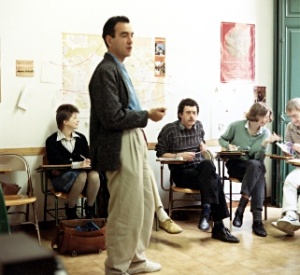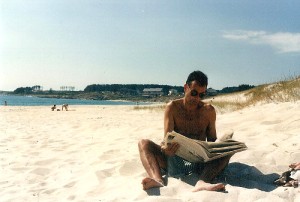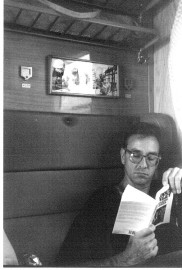 Me, in a pastelería (cake shop)
Me, in a pastelería (cake shop)
¿Qué es eso?
¿Cuál?
Ese pastel, allí.
Tarta de manzana.
¿Y aquella aquí… ¿Qué lleva?
Crema.
Si, quiero una de este.
Which translates, more or less, as:
What is that?
Which?
This cake, over there.
Apple tart.
And that one here, what’s in it?
Cream.
Yes, I want of one of this.
The translation is meant to convey the fact that the demonstratives (eso, ese, aquella, etc) are all over the place – literally – and only accidentally coincide with where I’m pointing, and with the gender or number of the thing pointed at. And, more tellingly, were I to have the same conversation again tomorrow, I might well use a whole different combination, plucked off the shelf, as it were, in a similarly random fashion.
This is as good an instance as any of how my Spanish, or pockets of it, functions in a state of ‘free variation’.
At some point, I must have been aware of the range of choices available for identifying objects near to me, near to you, and distant from both of us, and how these demonstrative adjectives and pronouns are also sensitive to number and gender, such that any decision to use one requires making a selection from 15 different options (see table below).
Understandably, I resisted learning the rules of a system that seemed impossibly complicated (three deictic points, three genders, as well as singular and plural). Instead I simply pulled demonstratives out of a hat, applying them indiscriminately, and sometimes throwing in a Catalan one for good measure. Of course, the physical context of the situations in which these items are typically used meant that pointing and eye-gaze made up for whatever incoherence resulted from my capricious grammar. Hence, there was little or no feedback as a result of miscommunication. I got the cakes I wanted.
 And so the system (or lack of system) became entrenched. The same thing, more or less happened with past tense forms, with dependent prepositions, with clitic pronouns, with por and para, and with ser and estar. There are even sets of like-sounding words that I also deploy in free variation, the verbs planear, plantear, plantar, and planificar being a case in point. These wildly chaotic sub-systems seem to co-exist alongside other systems that are relatively stable.
And so the system (or lack of system) became entrenched. The same thing, more or less happened with past tense forms, with dependent prepositions, with clitic pronouns, with por and para, and with ser and estar. There are even sets of like-sounding words that I also deploy in free variation, the verbs planear, plantear, plantar, and planificar being a case in point. These wildly chaotic sub-systems seem to co-exist alongside other systems that are relatively stable.
In complexity theory, the fluctuations between relative stability and instability within dynamic systems are well attested. As Lewin (1993. 20-21) puts it:
Most complex systems exhibit what mathematicians call attractors, states to which the system eventually settles, depending on the properties of the system. Imagine floating in a rough and dangerous sea, one swirling around rocks and inlets. Whirlpools become established, depending on the topography of the seabed and the flow of water. Eventually, you will be drawn into one of these vortexes. There you stay until some major perturbation, or change in the flow of water, pushes you out, only to be sucked into another. This, crudely, is how one might view a dynamical system with multiple attractors.
Language learning is similarly ‘chaotic’: as Larsen-Freeman (2006: 592) notes, ‘There are no discrete stages in which learners’ performance is invariant’. And she adds (p. 593) ‘Learners do not progress through stages of development in a consistent manner. There is a great deal of variation at one time in learners’ performances and clear instability over time’.
The transition from one attractor state to another is called a phase shift, and one definition of fossilization might be ‘the absence of phase shifts’. Thus, Ellis (1999: 472) argues that ‘fossilization arises when learners fail to resolve the inherent variation in their interlanguage’. Witness my demonstratives.
But proponents of complexity theory would argue that any such stasis is an illusion: there is no permanent ‘end state’ in evolving, dynamic systems. Hence ‘if there is no end state to language, it may be unhelpful to think in terms of fossilization as an end state to second language learning’ (Larsen-Freeman & Cameron, 2008: 10).
In a study of five Chinese learners of English, Larsen-Freeman tracked the ‘messiness’ of individual learning trajectories – a messiness not dissimilar to my random use of demonstratives. Larsen-Freeman conjectured that this very messiness might be indicative of the ‘instability that precedes a phase shift’ (2006: 611). And she adds, suggestively, ‘It is here where a pedagogical intervention might be optimal’ (ibid.).
What kind of pedagogical intervention?
I am drawn back to one of my favourite language learning accounts. Christopher Isherwood (1977:76), the writer, describes how he overcame a gap in his linguistic competence:
…Humphrey said suddenly, “You speak German so well – tell me, why don’t you ever use the subjunctive mood?” Christopher had to admit that he didn’t know how to. In the days when he had studied German, he had left the subjunctive to be dealt with later, since it wasn’t absolutely essential and he was in a hurry. By this time he could hop through the language without its aid, like an agile man with only one leg. But now Christopher set himself to master the subjunctive. Very soon, he had done so. Proud of this accomplishment, he began showing off whenever he talked: “had it not been for him, I should never have asked myself what I would do if they were to — etc., etc.” Humphrey was much amused.
In much the same way, I’m approaching the ‘holes’ in my own competence. How? A good old-fashioned students’ grammar, and a workbook of exercises. Hopefully, I will be able to find opportunities to activate, in real contexts (like the pastelería), the explicit knowledge gained from this mechanical practice, and trigger some kind of phase shift.
I’ll let you know how it goes.
References:
Ellis, R. (1999) ‘Item versus system learning: explaining free variation’, Applied Linguistics, 20/4, 460-80.
Isherwood, C. (1977) Christopher and His Kind: 1929-1939, London: Eyre Methuen.
Larsen-Freeman, D. (2006) ‘The emergence of complexity, fluency, and accuracy in the oral and written production of five Chinese learners of English,’ Applied Linguistics, 27/4, 590-619.
Larsen-Freeman, D. & Cameron, L. (2008) Complex Systems and Applied Linguistics, Oxford: Oxford University Press.
Lewin, R. (1993) Complexity: Life on the edge of chaos, London: Phoenix Books.
Sánchez Pérez, A. y Sarmiento González, R. (2005) Gramática práctica del español actual, Madrid: SGEL.






